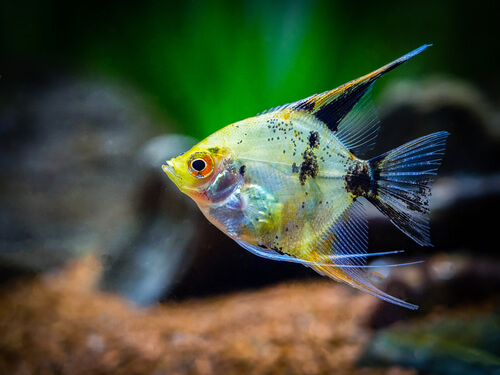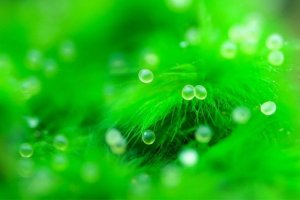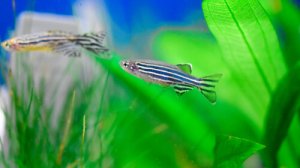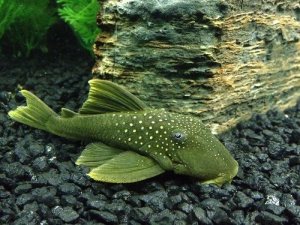Breed Overview
| Origin | Amazon and Orinoco river tributaries (Brazil and Venezuela) |
| Lifespan | 10-15 years |
| Size | 6-12” (15-30 cm) |
| Colour | Orange, black, and white |
| Food | Omnivorous, but prefers protein |
| Tank Size | Minimum 55 gallons/208 liters |
| Temperament | Semi-aggressive, social, hierarchical |
| Water Type | Freshwater |
| Water Temperature | 78-84 F/23-28 C |
| Water pH | 5-7.5 |
| Difficulty Level | Intermediate |
Species Summary
Koi angelfish, like other freshwater angelfish, are actually a variety of cichlid. However, unlike other cichlids, it has a unique flattened body shape that adapted to help it hide amongst plants, rocks, and driftwood in its original habitat – river basins in Brazil and Venezuela.
The koi angelfish is a captive-bred variety that has coloration similar to koi carp. It is not the same as the marine angelfish, which, although it has a similar body shape, comes from a different species and needs different conditions – saltwater as opposed to freshwater.
Ideal Koi Angelfish Tank Setup
Like other freshwater angelfish, these fish prefer a tank that mimics their natural habitat in the Amazon and Orinoco river systems.
This means a heavily planted tank with lots of places to hide – but getting the right water parameters for these fish is also important as they’re not hardy and can need quite specific conditions.
Koi Angelfish Size, Parameters, And Tank Height
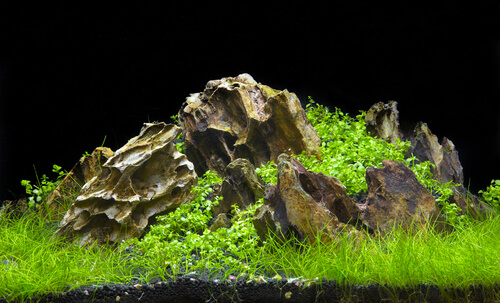
You may hear that for angelfish you need at minimum a 30-gallon/114-liter tank. However, to properly recreate the natural habitat of these fish, it’s best to opt for something much larger so you can give them the best opportunity.
Remember, just because a fish is surviving, doesn’t mean that it’s thriving. Ideally, a minimum 55-gallon/208-liter tank works best. Keep this fish in social groups of 5 or 6, and add an extra 15 gallons (57 liters) per fish, as these fish are territorial. Therefore, the more individual space they have, the less likely they are to have issues with aggression.
As they have a unique flattened shape and long trailing fins, angelfish need a tank that is sufficiently tall enough to give them space to swim. Plus, some fish feel more comfortable at different levels of the water. These fish grow taller than their length and can reach 8-10” in height (20-25 cm), so your tank height should ideally be double this.
Filter flow rate should be minimum 4x tank capacity, measured in gallons per hour. However, to maintain proper water quality, you should clean the tank once per week, changing 50% of the water.
Water Softness And Acidity
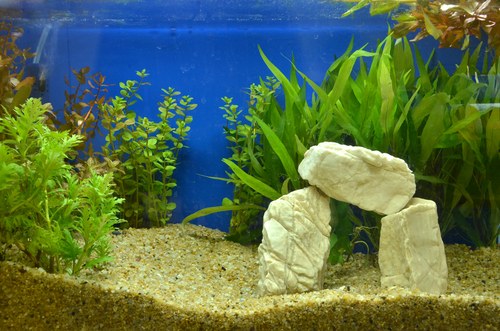
All freshwater angelfish actually require slightly acidic water that is also relatively soft. This is because the natural habitats they come from in the amazon are blackwaters – river systems that have high amounts of plant matter and carbon dissolved in them.
How Can You Maintain These Conditions In Your Tank?
RO Water, short for reverse osmosis, is water that has had some minerals removed from it and can be used if you’re unsure of the quality of your water. In fact, softer water supports lower pH as is required by these fish. Therefore if you have hard water but still want to keep this majestic species, this is an option.
CO2 Injection If you’re lucky enough to have soft water anyway but want to ensure the pH is kept down to create the optimum environment for your angelfish, CO2 injectors are devices that can fit on the side of your tank near the filter and inject carbon dioxide into the water. This does so by causing the formation of carbonic acid.
Tankmates
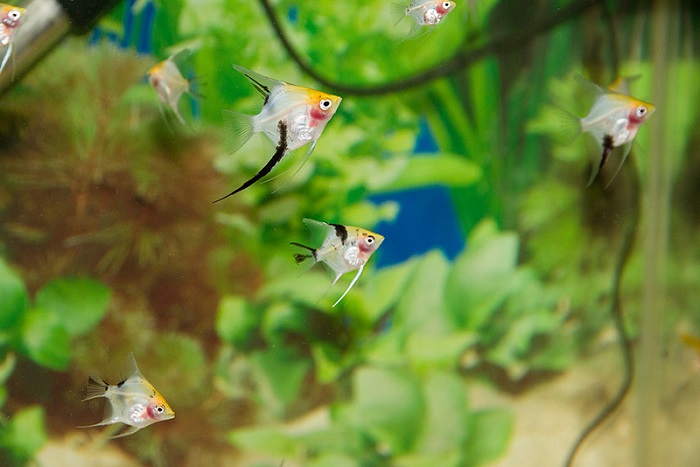
As angelfish, these guys do really well with other fish from their home, the Amazon Basin. However, they can actually get on with other fish too provided they share the need for soft acid water, which includes many species of tropical fish such as the following:
- Ram cichlids
- Swordtails
- Platies
- Mollies
- Keyhole cichlids
- Various types of tetras
They don’t enjoy being tankmates with fin-nipping fish as your angelfish will have beautiful trailing fins that can become tempting for fin-nippers. Likewise, some smaller fish are also not a good choice – especially if you keep them alone as opposed to in a shoal – as your angelfish might see them as prey.
Lastly, crustaceans such as snails or shrimps are not a good idea, as these would actually form part of your angelfishes’ diet in the wild.
Planting Your Tank
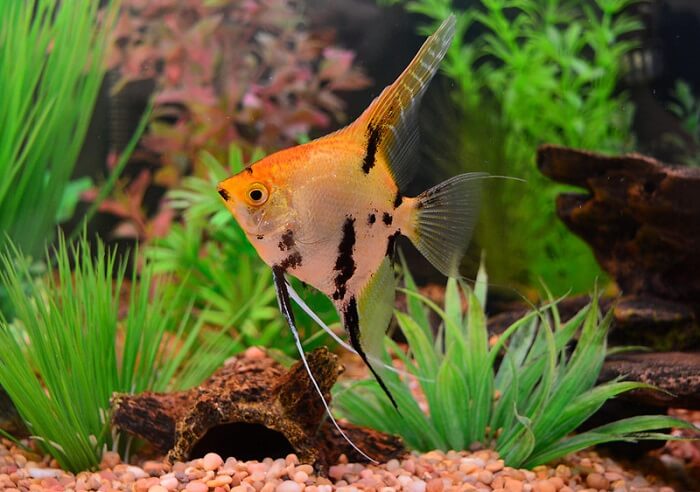
Setting up a planted tank for your angelfish can be one of the most fulfilling parts of keeping these fish. Like with any aquarium, bear in mind that once planted, you won’t be able to rearrange your tank.
Although some other species can thrive without many plants or decorations, for angelfish, this is not optional. These river-dwelling fish need a planted environment that offers them options to hide in as well as help maintain water quality. This encourages their natural behavior, offers stimulation, and helps solve hierarchical disputes. Good plants include:
- Amazon sword (females also love this as a place to hide their eggs)
- Anubias
- Java fern
- Java moss
- Amazon frogbit
- Cabomba
Feeding Koi Angelfish
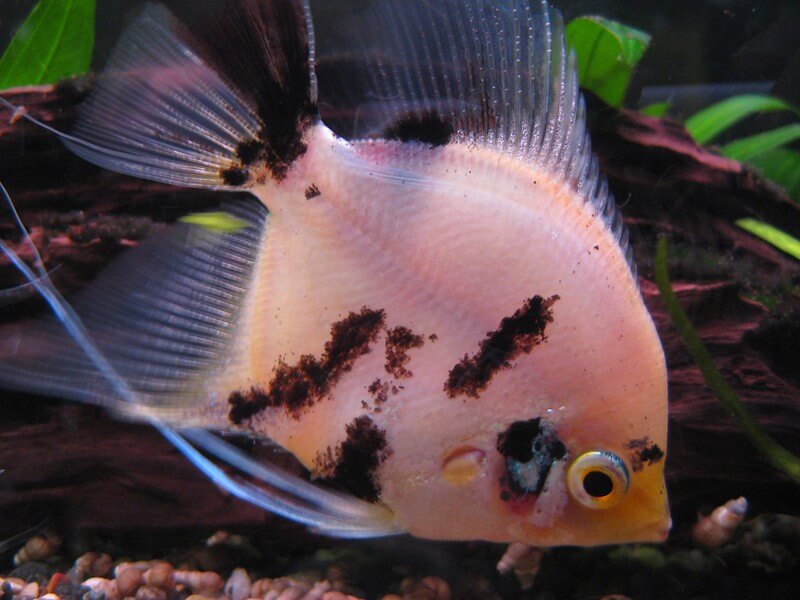
Due to their social nature and natural habitat, koi angelfish have particular feeding preferences that are important to bear in mind so you know what to expect before setting up a tank.
Diet Of Freshwater Angelfish In The Wild
Angelfish are omnivorous, but this can mean something very different for angelfish compared to other omnivorous fish. The majority of their diet is composed of live invertebrates and sometimes even smaller fish that they find in their natural habitat. Only a smaller amount is comprised of plant matter.
It can get difficult and expensive to give your fish a balanced diet based just on feeding live foods and vegetation so like with all species a good quality pellet food is one of the best options. These are sold either generically for tropical fish but if you want optimum nutrition for your angelfish, you can opt for one that is specifically for cichlids.
Feeding, Tank Size, And Hierarchy
Angelfish are sensitive fish with complex social systems, so tank dynamics and environment can influence their feeding habits. It’s important to know how to adapt to this, as hierarchy struggles can affect feeding. Therefore, minimize competition as much as possible, as sometimes this can be a reason your angelfish is not eating.
When feeding you can put some food at one end of the tank and some at another to ensure there isn’t too much competition between your fish and that the subordinate fish get fed enough. It’s important to monitor that all your fish are getting enough food and keep an eye out for any fish that is exhibiting strange behavior, as this can be a sign it is sick or dying.
Behavior And Temperament
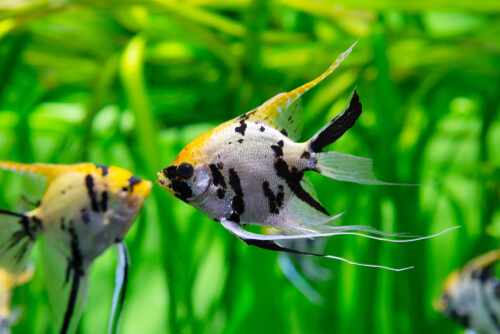
The koi angelfish is sometimes called a non-aggressive fish and sometimes called semi-aggressive. Therefore, if you’re new to this species, it may be hard to tell whether it’s right for you!
The truth is that any fish behavior is going to be heavily affected by its environment. Angelfish can be aggressive because they are territorial fish with a social hierarchy. However, if you give them enough space and the right conditions, you can keep aggression to a minimum.
Social Hierarchy In Angelfish
Angelfish actually have a complex social hierarchy formed of dominants and subordinates. This is why it is best to keep them in groups of five to six, so that this can properly develop. Dominants tend to eat more food and are more active than subordinates. Yet, before you become worried about fish aggression, scientific studies have shown that fish that are taken out of their social groups actually show a reduction in feeding and swimming.
Pests And Diseases:
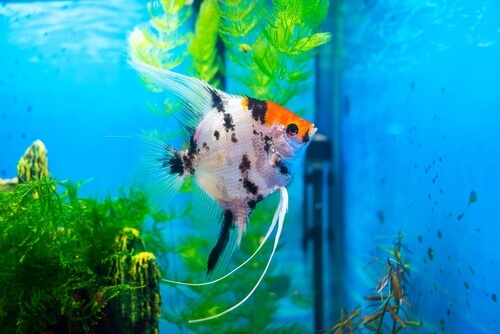
1. Parasitic Infections
Parasitic infections can be unpleasant for any fish, but as angelfish have an unusual shape and long fins there are additional sensitive spots that parasites can latch on to. Parasites range from ich to flukes but one thing they have in common is that they tend to be caused by poor water quality.
The majority of parasitic infections can be treated by isolating your fish in a separate tank and using either aquarium salts or over-the-counter medication until they are parasite free.
2. Fin Rot
Fin rot is important to spot in koi angelfish as they have long, flowing fins that can be vulnerable to poor water conditions. Look out for fins looking ragged and developing odd spots of color. These will often look sore and painful, very different from your fish’s naturally orange, white, and black coloration. Fortunately, as a bacterial infection, it can be treated by over-the-counter antibacterial medication. However, it’s always best to isolate your fish first in a separate tank.
Breeding Koi Angelfish
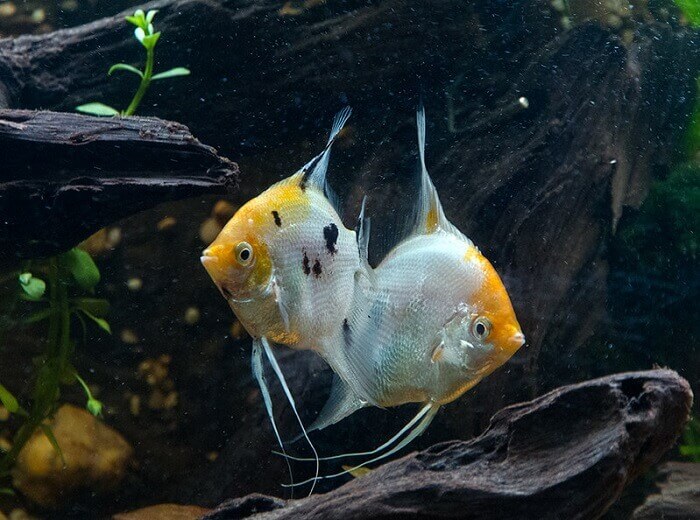
Unlike some fish such as the goldfish that are peaceful in their mating habits, angelfish choose a mate based on dominance and submission. Often, it is the more aggressive males that get to mate with a certain female. Females also use dominance and submission to indicate their readiness to mate.
If you are wondering how angelfish mate, you may be surprised to know that these fish choose their own mates. Therefore, it’s best to encourage this natural process when breeding them. It’s best if you’ve already had both experience with breeding other aquarium fish before, as well as enough familiarity with angelfish behavior that you are able to spot changes that can indicate readiness to mate:
- Fish spending all their time together
- Female carrying eggs, with a more rounded abdomen
- Fish locking lips
- Fish following each other
Breeding In A Community Tank:
As you’ll most likely be choosing your breeding pair from within a community tank, it’s important to ensure surrounding fish don’t affect breeding. Here are a few important things to note:
- Angelfish choose their own mates. Therefore, once your fish have reached sexual maturity (6-12 months) see if there are any fish that are spending all their time around each other. You can also see if a female is ready to spawn by observing if she is gravid (carrying eggs). Behavior changes are another indicator, as sometimes pregnant females won’t eat as much.
- Once you’ve identified a breeding pair, you can section them off with the tank divider. Make sure that the end of the tank you choose for your breeding pair has everything they need – so, some tankmates of a different species but also enough plants and hiding spaces that they will feel safe enough to mate.
- In a community tank, you’ll have to remove the eggs otherwise as the resulting fry grow they will become vulnerable to predation and the tank will become overcrowded. Using a specialist breeding slate for the eggs to attach to is best. Then you can simply lift it out of the tank. However, you’ll find the parents also love to lay them in plants, especially native plants, such as Amazon sword. These help them feel secure that they and their eggs are safe from predation, as they would need to be in the wild. If this happens you can try removing either all or part of the plant and placing it in a tank you’ve prepared for the fry.
Breeding In A Separate Tank:
This can be recommended in order to prevent issues with aggression and other fish-eating angelfish eggs. However, given that tank dividers can accomplish the same things, this is a riskier option as acclimatizing your angelfish to a new environment before breeding can actually stress them out. These fish prefer to keep things constant so it’s best not to let them get stressed before breeding.
Looking After Koi Angelfish Fry:
Within the first few days after hatching, koi angelfish fry get all the nutrition they need from the yolk sacs of their eggs. By the time they have finished with these, they will be large and strong enough that they can feed on a specialist fry food and as they grow you can add in live protein, like bloodworms, white worms, and water fleas.
Final Thoughts
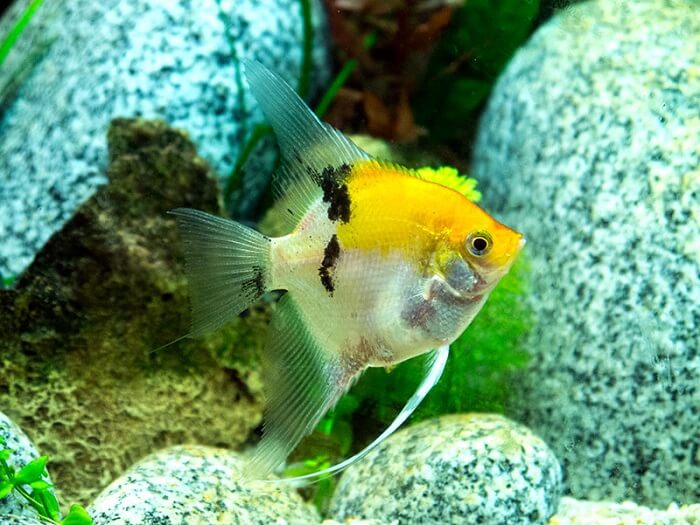
Although koi angelfish are a modern variety of angelfish that has been selectively bred to show specific colors, their needs are more or less the same as wild angelfish. Ultimately these are great fish to keep in a larger tank with a group of other angelfish, as well as shoals of compatible tankmates. In fact, they are much easier to look after than their exotic and delicate appearance might suggest.

